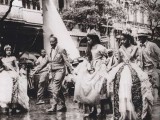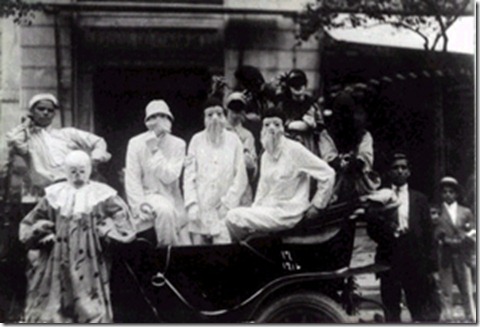Este post também está disponível em:
Português
English

Salvador’s carnival is today the biggest festival of popular participation on the planet.
During six days of carnival, around 2 million revellers walk the circuits, baptised Batatinha, Dodô and Osmar. But it wasn’t always like this.
Until the end of the 19th century, the petty bourgeoisie and the elite enjoyed themselves in parades and clubs, with masked balls to the sound of marchinhas.
The titles of the circuits are tributes to great names in Bahian carnival.
“They are fitting tributes to Dodô and Osmar, creators of the trio elétrico, and also to Batatinha, one of the great names of Bahian samba, proof that samba is from here,” says historian Manuel Passos, who also advocates a tribute to Orlando Campos, creator of the Trio Tapajós. “Between 1963 and 1979, when Dodô and Osmar were away, it was Trio Tapajós that held Bahia’s carnival together. So I think he still needs to be honoured,” he says.

História do Carnaval de Salvador
In Baixa dos Sapateiros, the black party was rocked by the groups Embaixada Africana and Pândegos D’África. The “watershed” in the Folia de Momo really came in 1950, with the creation of the 2010 homage: the trio elétrico.
The arrival of the party’s most animated car, with its electric guitars and the people in an uproar, created the party’s first circuit: Osmar, between Campo Grande and Rua Chile. “It was a single circuit and everything was concentrated there. There were meeting points for the young people, the trios,” explains the historian.
At the beginning of the 1980s, the second circuit emerged, known as Barra-Ondina, but officially baptised Dodô.
The restoration and elevation of the Pelô to World Heritage status gave rise to the last of the festival’s circuits, in the streets of the Historic Centre, called Batatinha.
“A very fitting tribute to one of the greatest names in samba in Bahia, Batatinha, proof that samba is Bahian,” says Passos.
Choosing one of the three circuits implies adopting different schedules and musical genres. For Passos, the Bahian carnival has always been a stage for mixtures, of all rhythms. “Everything is allowed. Once Ave Maria was played at 6pm on top of the trio elétrico, with everyone silent, it was one of the most beautiful scenes I’ve ever witnessed,” he says.
Circuitos de carnaval, baptised Batatinha, Dodô and Osmar
Osmar – This is the circuit where most of the alternative blocos can be found, especially until Carnival Sunday. Afro blocos, such as Malê Debalê, Munzenza, Bankoma, Ilê Aiyê and Cortejo Afro, and children’s blocos also pass through this circuit.
From Sunday onwards, the more traditional axé music-orientated blocos begin to pass through the circuit. Ivete Sangalo, Claudia Leitte, Banda Eva and Rei Momo’s trio will delight revellers between Campo Grande and Praça da Sé.
Dodo – The vast majority of elite blocos take this route.
“The emergence of the Dodô circuit meant that the elite moved there, leaving the Osmar circuit a little to one side,” says historian Manuel Passos. Asa de Águia, Timbalada, Cheiro de Amor, Ivete Sangalo and the Queen of Axé, Daniela Mercury, line the Barra-Ondina route. This year, Moraes Moreira will also be performing, in celebration of the trio’s 60th anniversary. Pepeu Gomes, Rei Momo, also receives guests on this circuit.
Batatinha – The independents are concentrated on the historic circuit. Levada do Jegue, Filhos e Filhas de Gandhy, Corisco and Carnapelô are some of the main ones parading through the streets of Pelourinho.
For Manuel Passos, the division of the Bahian carnival into circuits has given the revelry a new face, especially with the creation of the most visited circuit, Barra-Ondina. “We need to find ways to re-establish the Osmar circuit as it was before, as the meeting point it always was,” he adds.
Bahia.ws is the largest travel and tourism guide for Bahia and Salvador.



















